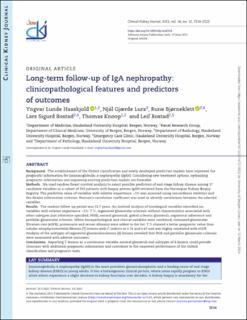| dc.contributor.author | Haaskjold, Yngvar Lunde | |
| dc.contributor.author | Lura, Njål | |
| dc.contributor.author | Bjørneklett, Rune Oskar | |
| dc.contributor.author | Bostad, Lars Sigurd | |
| dc.contributor.author | Knoop, Thomas | |
| dc.contributor.author | Bostad, Leif Henry | |
| dc.date.accessioned | 2024-03-12T14:37:40Z | |
| dc.date.available | 2024-03-12T14:37:40Z | |
| dc.date.created | 2023-07-18T15:07:45Z | |
| dc.date.issued | 2023 | |
| dc.identifier.issn | 2048-8505 | |
| dc.identifier.uri | https://hdl.handle.net/11250/3122010 | |
| dc.description.abstract | Background: The establishment of the Oxford classification and newly developed prediction models have improved the prognostic information for immunoglobulin A nephropathy (IgAN). Considering new treatment options, optimizing prognostic information and improving existing prediction models are favorable.
Methods: We used random forest survival analysis to select possible predictors of end-stage kidney disease among 37 candidate variables in a cohort of 232 patients with biopsy-proven IgAN retrieved from the Norwegian Kidney Biopsy Registry. The predictive value of variables with relative importance >5% was assessed using concordance statistics and the Akaike information criterion. Pearson's correlation coefficient was used to identify correlations between the selected variables.
Results: The median follow-up period was 13.7 years. An isolated analysis of histological variables identified six variables with relative importance >5%: T %, segmental glomerular sclerosis without characteristics associated with other subtypes (not otherwise specified, NOS), normal glomeruli, global sclerotic glomeruli, segmental adherence and perihilar glomerular sclerosis. When histopathological and clinical variables were combined, estimated glomerular filtration rate (eGFR), proteinuria and serum albumin were added to the list. T % showed a better prognostic value than tubular atrophy/interstitial fibrosis (T) lesions with C-indices at 0.74 and 0.67 and was highly correlated with eGFR. Analysis of the subtypes of segmental glomerulosclerosis (S) lesions revealed that NOS and perihilar glomerular sclerosis were associated with adverse outcomes.
Conclusions: Reporting T lesions as a continuous variable, normal glomeruli and subtypes of S lesions could provide clinicians with additional prognostic information and contribute to the improved performance of the Oxford classification and prognostic tools. | en_US |
| dc.language.iso | eng | en_US |
| dc.publisher | Oxford University Press | en_US |
| dc.rights | Navngivelse-Ikkekommersiell 4.0 Internasjonal | * |
| dc.rights.uri | http://creativecommons.org/licenses/by-nc/4.0/deed.no | * |
| dc.title | Long-term follow-up of IgA nephropathy: clinicopathological features and predictors of outcomes | en_US |
| dc.type | Journal article | en_US |
| dc.type | Peer reviewed | en_US |
| dc.description.version | publishedVersion | en_US |
| dc.rights.holder | Copyright 2023 the authors | en_US |
| dc.source.articlenumber | 2514–2522 | en_US |
| cristin.ispublished | true | |
| cristin.fulltext | original | |
| cristin.qualitycode | 1 | |
| dc.identifier.doi | 10.1093/ckj/sfad154 | |
| dc.identifier.cristin | 2162727 | |
| dc.source.journal | Clinical Kidney Journal (CKJ) | en_US |
| dc.identifier.citation | Clinical Kidney Journal. 2023, 16 (12), 2514–2522. | en_US |
| dc.source.volume | 16 | en_US |
| dc.source.issue | 12 | en_US |

